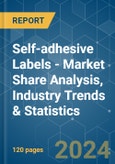The Self-adhesive Labels Market size is estimated at USD 50.35 billion in 2024, and is expected to reach USD 65.72 billion by 2029, growing at a CAGR of 5.47% during the forecast period (2024-2029).
The COVID-19 outbreak and the subsequent nationwide lockdowns, disruption in manufacturing activities and supply chains, and production halts negatively impacted the market in 2020. However, the conditions started recovering in 2021, restoring the market's growth trajectory for the forecast period.
This product will be delivered within 2 business days.
The COVID-19 outbreak and the subsequent nationwide lockdowns, disruption in manufacturing activities and supply chains, and production halts negatively impacted the market in 2020. However, the conditions started recovering in 2021, restoring the market's growth trajectory for the forecast period.
Key Highlights
- The rapidly growing e-commerce industry and increased consumption of food and beverage products will likely drive the market demand.
- Conversely, increasing government regulations and the availability of substitutes like linerless labels will likely hinder market growth.
- The increasing demand for bio-based self-adhesives with a shift to sustainable practices will act as an opportunity for the market studied.
- Asia-Pacific dominated the market with a significant share and is expected to continue its dominance during the forecast period.
Self Adhesive Labels Market Trends
Increasing Demand from the Food and Beverage Industry
- Self-adhesive labels are known to improve the aesthetic characteristics of food and beverage packaging brands. Packaging and labeling play an essential role in the sale of products, as they help grab consumers' attention. Marketers mainly use them to encourage potential consumers to purchase the product. Labels communicate how to use, transport, recycle, and/or dispose of the package or product.
- Labeling provides ingredient information, product identification, and cautionary notifications in the food and beverage sector. Self-adhesive label manufacturers must comply with the legal requirements to ensure the adhesive does not affect the food ingredients.
- Furthermore, the global food packaging market is estimated to reach around USD 362 billion by the end of this year and USD 463.65 billion in 2027. Thus, the growing food packaging market will increase the demand for self-adhesive labels in the coming years.
- According to the US Department of Commerce, in January 2023, the total sales of retail and food services stores stood at USD 78.27 billion. In contrast, in January 2022, the figure stood at USD 74.98 billion. There is a substantial increase of approximately 4.39%, which is expected to increase further.
- Moreover, various food processing companies invest in new plants and capacity expansions of the packaged food business. Under the Production Linked Incentive (PLI) scheme, the Indian government received investment proposals from 60 processed food companies, including Hindustan Unilever, Amul, Nestle, Dabur, ITC, Parle, and Britannia.
- Thus, the abovementioned factors will likely increase the demand for self-adhesive labels in the forecast period.
Asia-Pacific to Dominate the Market
- Asia-Pacific dominated the market and is expected to grow significantly over the forecast period. With the growing packaging, electronics, and personal care industries in countries like China, India, Japan, and South Korea, the consumption of self-adhesive labels is increasing.
- In 2022, the total export of personal care and cosmetics from China stood at USD 5.63 billion; in 2021, the figure was USD 4.85 billion. There is an increase of 16.08% compared to the previous year, which is expected to increase further.
- China is the largest base for electronics production. Electronic products, such as smartphones, TVs, and other personal devices, recorded the highest growth in electronics. The country serves the domestic demand for electronics and exports electronic output to other countries. With an increase in disposable incomes of the middle-class population, the demand for electronic products is projected to increase.
- According to ZEVI, the Asian electro market reached EUR 3.11 trillion (USD 3.674 trillion) in 2021, a 10% rise. The market increased by 13% in 2022 and estimated a 7% growth rate for 2023. China's market is the largest in the world, even larger than the combined markets of all industrialized countries. Additionally, the Chinese electronic industry expanded by 14% in 2022, and the sector is expected to grow by 8% in 2023
- Self-adhesive labels are widely used in packaging medicines and medical equipment imported or exported to different countries. According to the government of India, the Indian pharma industry market size is expected to reach USD 130 billion by 2030. India provides pharmaceutical products to more than 200 countries and may continue to do so.
- India's fifth-largest packaging industry is growing significantly, led by economic growth, demographic dividend, and growing e-commerce. For instance, in January 2022, Flipkart announced expanding its grocery services and will offer services to 1,800 Indian cities. In June 2022, Amazon India signed an MoU with Manipur Handloom & Handicrafts Development Corporation Limited (MHHDCL), a Government of Manipur Enterprise, to support the growth of artisans and weavers across the state.
- Such factors will likely drive the market demand studied during the forecast period.
Self Adhesive Labels Industry Overview
The market studied is fragmented. Some key players in the market include (not in any particular order) 3M, Avery Dennison Corporation, UPM, Mondi, and LINTEC Corporation, among others.Additional Benefits:
- The market estimate (ME) sheet in Excel format
- 3 months of analyst support
This product will be delivered within 2 business days.
Table of Contents
1 INTRODUCTION
4 MARKET DYNAMICS
5 MARKET SEGMENTATION (Market Size in Value)
6 COMPETITIVE LANDSCAPE
7 MARKET OPPORTUNITIES AND FUTURE TRENDS
Companies Mentioned (Partial List)
A selection of companies mentioned in this report includes, but is not limited to:
- 3M
- Asteria Group
- Avery Dennison Corporation
- CPC Haferkamp GmbH & Co. KG
- Fuji Seal International, Inc.
- H.B. Fuller Company
- HERMA
- LECTA
- LINTEC Corporation
- Mondi
- Optimum Group
- Symbio, Inc.
- Thai KK Group
- UPM
Methodology

LOADING...










